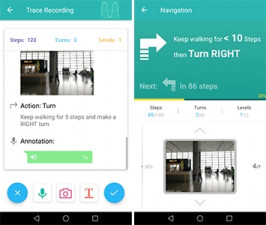
The tech giant researchers have developed an indoor navigation app, called Path Guide, which does not rely on Wi-Fi or GPS signal.
Google Maps and similar apps do not work inside buildings as satellite signals can access the user's exact location. This can be troublesome in expansive buildings such as hospitals, malls, parking garages, or offices, where a map is often needed.
Microsoft researchers, Yuanchao Shu and B"orje Karlsson, part of the company's Asia Cloud & Mobile Research group who launched Path Guide, say in a statement the app provides low-cost, plug-and-play indoor navigation services.
Path Guide uses magnetic sensor data gathered from different locations and the sensors within smartphones to lets app users 'follow' the traces created by someone before. This means the building do not require any special sensors or Wi-Fi signal.
"Experiments have determined that the indoor geomagnetic field is disturbed by building structures, and that it is relatively stable inside buildings. This gave us the idea of creating an indoor navigation system based on the magnetic sensor data gathered from different locations, while leveraging the other phone sensors to support real time navigation instructions," say Shu and Karlsson.
Users can easily find the correct path to their destinations by simply following traces created by a 'leader' - a user who has been to the location before and traced a path.
"To make the system work for anyone, we developed a peer-to-peer leader/follower model.
Once a user goes to an indoor location using the app to record sensor data along a path, any other user can follow that path and get there. As more users collect data, different paths can be combined that make the system even more useful," say the researchers.
Anyone can act as a guide and the paths are available in the app for anyone visiting the destination to use.
Leaders can also add text, audio and pictures along the path to clear up tricky situations, such as which stairwell to take.
Users can also follow the paths backwards which would be useful to people who have parked in an unfamiliar parking garage.
The research team says it will be improving the apps usability based on feedback it receives from users.
The app is available now to download for Android users here.
Share